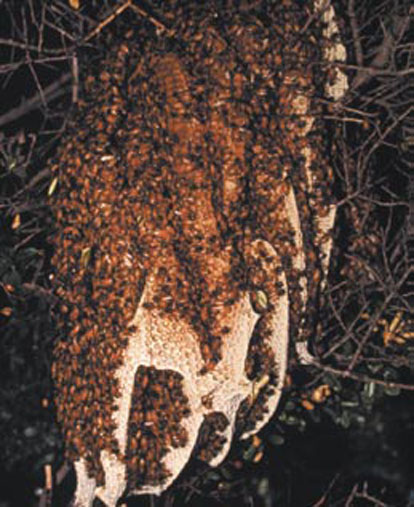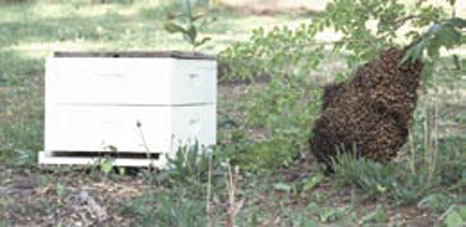What is a swarm? Swarming is the natural mode
of reproduction for a honey bee colony in spring.
Swarming is induced as bees increase their population
size and require more space. A swarm usually consists
of the old queen (sometimes a new one) and 50 to 60
percent of the worker bees in the swarming colony.
Workers preparing to swarm engorge themselves
on honey and force the old queen out of the hive.
Changing weather conditions from cool and rainy to
warm and sunny seem to stimulate the natural urge of
bees to swarm.

Most swarms leave the colony in good weather
between 10 a.m. and 2 p.m., fly to a nearby tree or
bush and land on a limb. Immediately after landing
and for the next 24 to 36 hours, the bees are very
docile; they are interested in swarming, not in
defending their colony. Scout bees come out of the
cluster of the swarm and search the local area for
a protected location for the colony. The scout bees
communicate the information to the swarm and a
“decision” is made, whereupon the bees leave the
branch and proceed to their new location.
After arriving at the new location, or rarely if
the swarming bees have failed to find a location (see
photo at right), the bees start to build wax comb and the
queen lays eggs to start a new brood nest. After brood
production commences, the new colony will become
defensive of its new home.
Preparing for a “Swarm Call”
As a beekeeper you may be contacted by
neighbors, businesses and the county Extension office
as early as the month of March to go out and collect
a swarm. This request is a “swarm call.” Collecting
a swarm can be exciting, fun and a good way to start
a new colony with less expense. However, you must
be prepared to go and get the swarm at a moment’s
notice, because the swarm may depart quickly, not
“waiting” for you to get ready. You may want to
give your name and phone number to your county
Extension office so that your name can be put on a list
of beekeepers who are willing to retrieve swarms.

• Anticipate the call by finding a container to hold
the swarm (a cardboard box will do, but a hive body
with bottom and top works better); prepare sugar
syrup (1:1 sugar/water) in a squirt bottle; collect
smoker, fuel and matches, a strap to hold lid/top on
container, bee veil and a ladder.
• When the person calls announcing he or she needs
someone to retrieve a swarm, you should tell the
caller not to disturb the swarm or spray it with water,
soap or pesticide.
• The caller may be excited or even alarmed. Calm
the caller by explaining what is happening and that
swarming honey bees are not defensive or dangerous
unless disturbed.
• Explain that a swarm will usually move from the
original location within 24 to 48 hours; therefore, if
a beekeeper is not available to collect the bees from
a homeowner’s property, the bees will normally leave
without causing a problem.
• Ask questions to improve your chance of success in
collecting the swarm.
Questions to Ask about Swarms:
1. Are these really honey bees? Ask them what the
“cluster looks like.” You do not want yellowjackets
or hornets. Has anyone disturbed the cluster?
2. Get permission from the landowner/homeowner to
collect the swarm from his or her property.
3. Be sure to write down the name, address and
phone number, including work number of the
homeowner or someone who will be on site.
4. Ask for directions of how to find the swarm
location, including where on the property.
5. How long have the bees been there?
6. How high off the ground are they? Will you need a
ladder?
7. How big is the swarm (beach ball, football size,
etc.)?
8. Ask the caller if it’s all right (or acceptable) if
you snip a branch of the tree or bush holding the
swarm.

How to Collect a Swarm – This Is the Fun Part!
Let’s start with an “ideal swarm” example to start
with. This swarm has formed in a small tree, 5 feet
above level ground in a fenced yard. The homeowner
reports the swarm has been there only 20 minutes.
• Place the whole cluster of bees, including the queen,
directly into an empty hive body or nucleus (smaller
version). This way frames can be gradually added to
this “colony” and there is no need to shift the bees
into a hive later. Some beekeepers like to lay the
cluster down on a sheet in front of the hive and let
the bees walk into the hive on their own. This is your
choice.
• Mist the hanging cluster of bees lightly as well as the
inside surfaces of the hive body and frames (those
that can fit in easily with the swarm) with 1:1 sugar:
water syrup.
• If the bees are clustered on a low branch, snip it and
carefully lower the branch and bees into the hive.
• If it’s not possible to cut the branch, then place the
hive body below and surrounding the bottom of
the cluster, if possible. Then shake the branch to
dislodge the bees into the hive body. If shaking isn’t
an option, then gently brush or scoop the bees with a
gloved hand down into the hive body.
• Add frames gradually to the middle area to fill the
box as bees move up onto frame surfaces.
• Carefully look on the branch for a missed queen and
scoop any clusters gently into the box.
• Crack the lid on the box for a few minutes to allow
stragglers to find the new colony.
You may need to leave the new colony in this
location overnight if many bees are flying around. In
other situations everything happens quickly and you
can put them in and leave within a few minutes. This
may depend, in part, on how long the swarm has been
in this location.
Attach the top to the hive body and secure
window screen in the entrance with staples to keep
bees inside while providing ventilation. Strap the unit
together and move it to the new location.
You will need to modify this method to fit your
unique situation. Not all swarms cluster this close to
the ground on an easy-to-reach branch. You will need
to decide if the swarm is too high or on a structure
that is out of reach for safe retrieval. We have collected
swarms from interesting places such as vehicles,
grocery shopping carts, mailboxes, statues and from
eaves of buildings.
Source:
Skinner, Parkman, Studer, and Williams. 2004. Beekeeping in Tennessee. University of Tennessee Extension PB1745. 43p.
